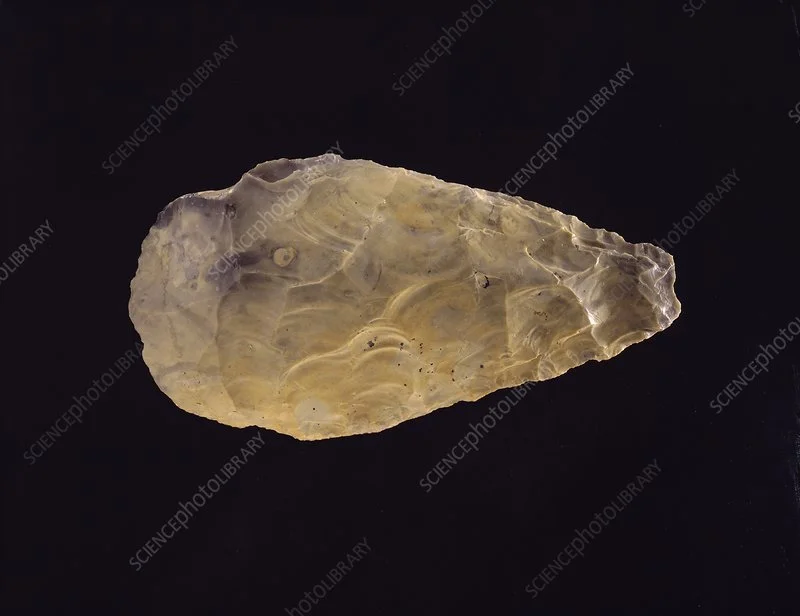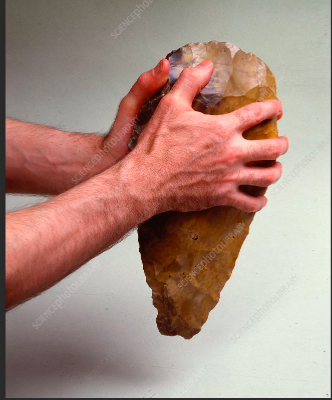Knapping as a link to the ancients
I have been practicing and breaking rock on a minimal level. Issues at home and at work have prevented me from doing too much, but I just got more rock, so I’m gearing up for summertime.
Until I get more knapping done, let’s consider what I’m actually DOING when I am attempting flintknapping. I’m sticking a toe into the past. The procedure of knapping, the sights, and the sounds are all familiar things our ancestors would have known and been familiar with. All over the world, ancestral stoneworkers used the same procedure I am learning since at least the Paleolithic period.
Paleolithic means Old Stone Age (Stone Age meaning stone tool age, basically), Mesolithic means Middle Stone Age, and Neolithic means New Stone Age. Each of these periods used and improved upon stone tools, but they were similarly used. Anything you’d use a knife for today, was stone back in those days, plus hunting points and defense.
Now I was in a conversation online recently where someone suggested that only specific men were flintknappers. I am not certain I agree with this theory. For many reasons, I am against placing modern gender roles back onto our ancestors, because…..and this is crucial….think of your own knife drawer. If you were chopping food for dinner, and you need a sharper knife, are you really going to wait till your male family member gets home to sharpen your knife? No, of course not. You’re going to pull out your knife sharpener and fix it so you can get dinner on. Delay wouldn’t be a good idea in the Stone Age where microwaves aren’t possible to hurry dinner along, right?
So, I can only conclude that that both men and women had a rudimentary knowledge of knapping, and even if there were those who were more highly skilled and perhaps “quicker” at it, you are unlikely going to have to go to them to resharpen your edge. OR that’s my working theory anyway.
I suppose, too, growing up in a family where women hunted and processed meat for the family table, and a family that had a smoke house off the back porch has made me think of things on a broader scale. However, I still maintain that I am correct.
Yes, there would be artisans, and this is but one example of a piece that couldn’t possibly have a functional purpose. This is an image of the Furze Platt Hand Axe found in England and now housed in the British Museum. This is a beautiful example of the skill of the artisan. WHY? Because this is HUGE!!
This axe is around 12 inches in length from base to tip and weighs around 6 pounds. Using this as a hand axe would be nearly impossible. However, the artisan’s standing in the tribe as a master knapper would be easily visible to anyone that saw this lovely piece.
Some pieces are just simply artistic because they show off the beauty of the stone. Here’s a piece by master knapper, Clint Kight of Ohio. This piece is from Flintridge stone and is one of the most beautiful pieces in color alone. However, if you look very closely, the flakes are uniform and all spread nearly identically to the midline of the stone. That’s hard to do.
So, what is the takeaway here?
For me, this is about communing with the ancestors. Doing something they would recognize even if I was sitting on the porch in the 21st century making a hand axe myself. We would share a common language in the stonework and that is amazing. Of course, they would think I was AWFUL at this, since I’m still learning, but maybe they would be patient and teach me a few things.
It is also about creating art. There is no way you can look at Mr. Kight’s piece and not think it beautiful. Even our ancestors revered art and skill and pretty things….the Furze proves that, but there are other pieces out there also as proof. Many cultures revered knapped knives for ceremonial reasons and wanted specific stones for that reason alone.
Our ancestors thought of the natural world differently than we did, but make no mistake, this wasn’t just a “man’s game.” Women would have known and recognized this craft, too. I’m sure of it. Men may have historically been the most hunters of the tribe, but their women had to use the hand axe and blades to divide the kill.
I have no doubt my Shawnee and Saponi ancestors would be glad I was trying to learn their skills…..but they would certainly also doubt my ability at present. However, my lack of skill at present makes me very aware of the skills of the artisans when I see them.



